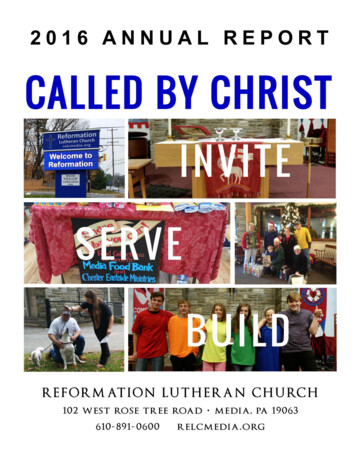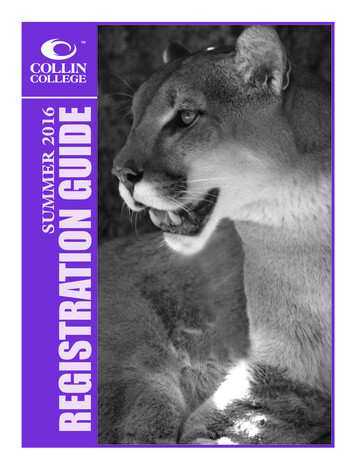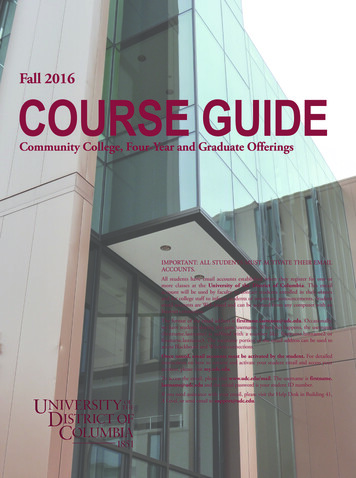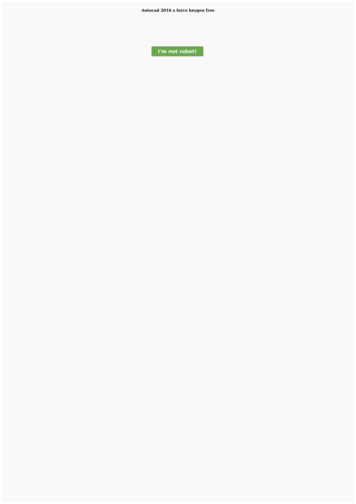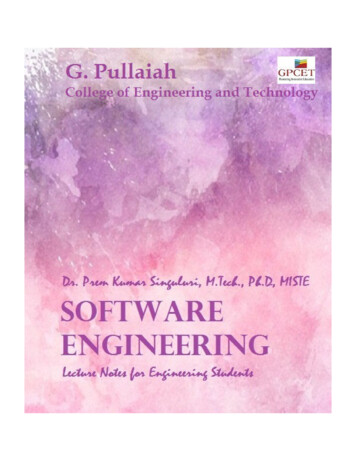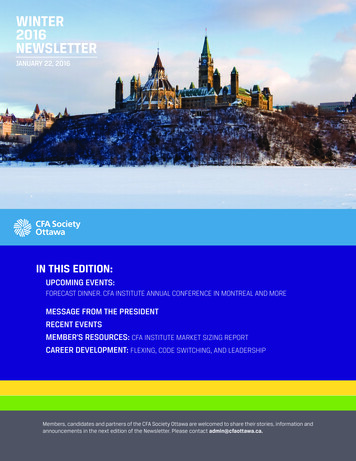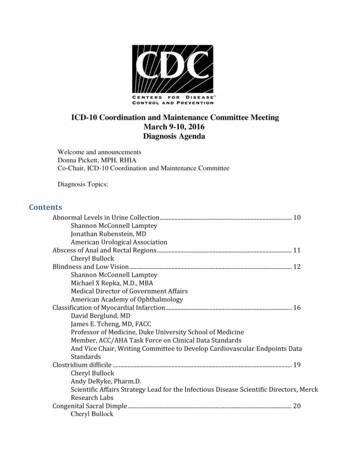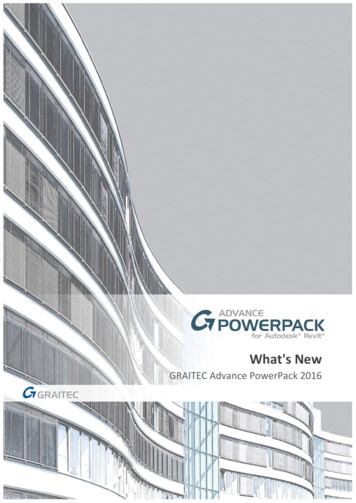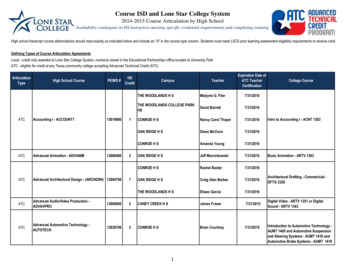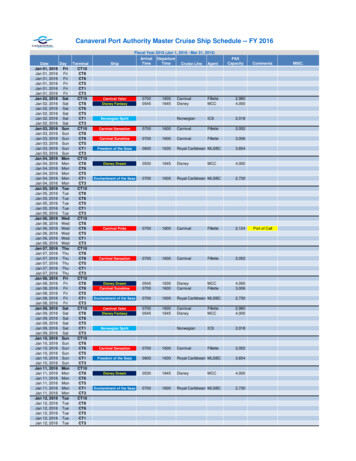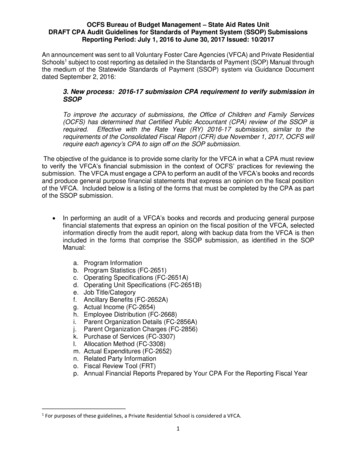
Transcription
OCFS Bureau of Budget Management – State Aid Rates UnitDRAFT CPA Audit Guidelines for Standards of Payment System (SSOP) SubmissionsReporting Period: July 1, 2016 to June 30, 2017 Issued: 10/2017An announcement was sent to all Voluntary Foster Care Agencies (VFCA) and Private ResidentialSchools1 subject to cost reporting as detailed in the Standards of Payment (SOP) Manual throughthe medium of the Statewide Standards of Payment (SSOP) system via Guidance Documentdated September 2, 2016:3. New process: 2016-17 submission CPA requirement to verify submission inSSOPTo improve the accuracy of submissions, the Office of Children and Family Services(OCFS) has determined that Certified Public Accountant (CPA) review of the SSOP isrequired. Effective with the Rate Year (RY) 2016-17 submission, similar to therequirements of the Consolidated Fiscal Report (CFR) due November 1, 2017, OCFS willrequire each agency’s CPA to sign off on the SOP submission.The objective of the guidance is to provide some clarity for the VFCA in what a CPA must reviewto verify the VFCA’s financial submission in the context of OCFS’ practices for reviewing thesubmission. The VFCA must engage a CPA to perform an audit of the VFCA’s books and recordsand produce general purpose financial statements that express an opinion on the fiscal positionof the VFCA. Included below is a listing of the forms that must be completed by the CPA as partof the SSOP submission. In performing an audit of a VFCA’s books and records and producing general purposefinancial statements that express an opinion on the fiscal position of the VFCA, selectedinformation directly from the audit report, along with backup data from the VFCA is thenincluded in the forms that comprise the SSOP submission, as identified in the SOPManual:a.b.c.d.e.f.g.h.i.j.k.l.m.n.o.p.1Program InformationProgram Statistics (FC-2651)Operating Specifications (FC-2651A)Operating Unit Specifications (FC-2651B)Job Title/CategoryAncillary Benefits (FC-2652A)Actual Income (FC-2654)Employee Distribution (FC-2668)Parent Organization Details (FC-2856A)Parent Organization Charges (FC-2856)Purchase of Services (FC-3307)Allocation Method (FC-3308)Actual Expenditures (FC-2652)Related Party InformationFiscal Review Tool (FRT)Annual Financial Reports Prepared by Your CPA For the Reporting Fiscal YearFor purposes of these guidelines, a Private Residential School is considered a VFCA.1
OCFS Bureau of Budget Management – State Aid Rates UnitAudit Guidelines for Standards of Payment System (SSOP) SubmissionsReporting Period: July 1, 2016 to June 30, 2017 Issued: xx/2017The reporting period for the general purpose financial statements and the SSOP are generallythe same. Unless otherwise previously approved by OCFS, the time period the SSOP formscover July 1, 2016 through June 30, 2017. If the VFCA reports on a different reporting cycle, theVFCA must request an Alternative Period by using the Alternative Period Request Form (inSSOP). This period must agree with the VFCA’s CPA report year. OCFS does not accept interimor part-year data for submission of rate calculation.General InformationAnnual voluntary VFCA SSOP system and FRT report submissions are due on November 1st.Upon request, OCFS may grant an extension of 30 calendar days. A further extension may begranted for a second period of 30 calendar days. Submissions are considered timely if they arereceived within fifteen calendar days after the due date or the date of the last approved extension.OCFS guidelines are based upon the following assumptions: The accrual basis for accounting is required. The SOP Program Manual contains the instructions for the specific cost report periodbeing audited/examined. The independent certified public accountant must have aworking knowledge of the Manual including all updates, particularly those detailed in theSSOP Guidance Document letter for the relevant period. The SOP Manual and GuidanceDocuments are available at:oSOP Manual: fault.aspoSSOP Guidance Documents: http://my.ny.gov/ssop Income and expenses entered in SSOP should reconcile to the financial statements. Note: Each VFCA must make a submission to OCFS for each institution, group residence,group home program, VFCA boarding home program, and family foster boarding homeprogram as well as an approved school for the handicapped; an income and expenditurereport for the past fiscal period, including a program description and any supplementalreports in whatever form specified by OCFS.SPECIFIC FORMSFC Form – FISCAL REVIEW TOOLOCFS traces amounts on the FRT Report to the audited financial statements (CPA reports). AVFCA cannot submit their annual SSOP report without first submitting the annual FRT report.Draft CPA report data will be acceptable for the preliminary FRT score as final CPA reports arenot due until 30 days after the SSOP submission. SSOP will include a provision for enteringparent organization data, if applicable to the VFCA. Preliminary FRT data can be revised at alater date by the VFCA, if necessary.2
OCFS Bureau of Budget Management – State Aid Rates UnitAudit Guidelines for Standards of Payment System (SSOP) SubmissionsReporting Period: July 1, 2016 to June 30, 2017 Issued: xx/2017FC Form – PROGRAM INFORMATIONOCFS maintains the program names and types for the Group Care and Foster Care programsthat have an active MSAR Program and verifies the MSAR Programs are reported separately and“Non-MSAR Programs” are reported as noted below. The VFCA is required to provide programinformation for those programs that do not receive MSAR funding. The “Non-MSAR Programs”are:FC Medical Per Diem (Medicaid): Specialty CareGeneral CareBridges to Health (B2H) Health Care Integration AgencyBridges to Health (B2H) Waiver Services Provider AftercareFederalLocalNon-allowable cost center2OtherPrivateState – Dormitory Authority of the State of New York (DASNY)State – Division of Criminal Justice Services (DCJS)State – Department of Health (DOH)State – Office of Temporary and Disability Assistance (OTDA)State – Office for Alcohol and Substance Abuse Services (OASAS)State – Office of Children and Family Services (OCFS)State – Office of Mental Health (OMH)State – Office for People with Developmental Disabilities (OPWDD)State – State Education Department (SED)Other:FC Form 2651 – PROGRAM STATISTICS FOR GROUP CARE (GC) AND FOSTERBOARDING HOMES (FBH)OCFS compares current year amounts to the prior year submission amounts and questionssignificant changes in reported amounts. Specifically, OCFS looks for any significant changes in:Group Care:1. Care days – OCFS looks for significant changes in the number or the distribution of days(e.g., last year there were 200 Local DSS days, but only 40 this year)2“Non-allowable cost center” programs may be reported separately or in the aggregate.3
OCFS Bureau of Budget Management – State Aid Rates UnitAudit Guidelines for Standards of Payment System (SSOP) SubmissionsReporting Period: July 1, 2016 to June 30, 2017 Issued: xx/20172. Capacity – Changes in Capacity should be supported by an Operating Certificate (OC). Ifmultiple OCs were in effect during a RY, they are used, pro rata, to calculate an effectivecapacity for the RY based upon the average capacity times the days of operation dividedby the number of days the facility was open.Foster Boarding Home:1. Care days – OCFS reviews significant changes in the number or the distribution of days(e.g., last year there were 200 Local DSS days, but only 40 this year).2. Adoption numbers (FBH) – OCFS reviews significant changes (e.g., last year there were12 and this year none). OCFS questions when there are no adoptions reported. Adoptionsaffect parameter.Audit:1. OCFS, on a test basis, compares programs on SSOP to care days reports available tosupport the care days reported.FC Form 2651A – OPERATING SPECIFICATIONSReview: OCFS compares current year amounts to the prior year submission amounts and questionsignificant changes in reported amounts. Specifically, OCFS reviews any significantchanges in:oCapacity – Any changes in Capacity should be supported by an OperatingCertificate (OC).oOperating Days – The number of Operating Days will normally be a full year. Anychanges or variations would be substantiated by a check of the OperatingCertificate(s). An explanation may be submitted in the comment section if thosedays are different than the effective period pre-populated in this form. VFCA mustprovide a valid explanation (e.g. fire, repairs, or facility closed for a specifiedperiod), subject to Regional Office concurrence. Programs are classified according to the characteristics of the children in care. TheClassification determines a ratio of childcare workers to children for that program. After aprogram is classified, the staffing ratio, program capacity and program unit size are usedto determine the number of FTE childcare workers that will be used to determine theprograms child care parameter. This form is used to obtain information about the individual Group Care facilities within theprograms for which OCFS sets Maximum State Aid Rates. VFCA must confirm the Datesof Operation for every licensed facility that operated during the July 1 through June 30reporting period.4
OCFS Bureau of Budget Management – State Aid Rates UnitAudit Guidelines for Standards of Payment System (SSOP) SubmissionsReporting Period: July 1, 2016 to June 30, 2017 Issued: xx/2017FC Form 2652A – ANCILLARY BENEFITSReview:1. OCFS checks that the Executive Director’s salary has been reported, even if he/shereceives no Ancillary Benefits. Thus, OCFS expects to see salary and fringe benefit datafor an Executive Director with a salary of less than 100,000 and no Ancillary Benefits. Ascan of the FC Form 2668 comparing Total FTE’s to Total Amount may indicate otherindividuals receiving 100,000 or more annually. All should be reported.Audit:1. OCFS verifies that the Executive Director salary was reported, regardless of amount.2. OCFS verifies that all positions receiving 100,000 or more annually, and all positionsregardless of salary, for which the individual received fringe benefits which are above whatis provided to other employees are reported. Include a comprehensive description of eachbenefit. Examples of ancillary benefits that are to be reported are Housing, Food,Maintenance Services, Personnel Services, Transportation, Travel, Sabbatical, Bonuses,Contractual Items and Tuition Payments. It is not all-inclusive. Similar in-kind benefitsmust also be reported.FC Form 2654 – ACTUAL INCOMEReview:1. OCFS reviews the current submission and compares it to the previous year’s, looking forany significant changes (either by percentage or gross dollar amount) in reportedamounts. Descriptions given (for A, B, or C income) are reviewed to assure the incomeis in the correct section.2. Applied Income (A-income) that is used to reduce operational expenses, and will beautomatically “applied” in the rate calculation to reduce the net rate base before calculatingthe MSAR.3. Fee for Service (B-income) that represents payments for services provided in the program.Other Income (C-income) that represents other sources of income associated with theprogram.4. OCFS reviews B- and C-income items that should be used to reduce a line item expenseon the 2652 expense report. If a lesser amount is reported on the 2652 than on the 2654for the applicable income, only reduce the amount of the expense back to 0 (i.e., do notcreate a negative expense). Examples are:5
OCFS Bureau of Budget Management – State Aid Rates UnitAudit Guidelines for Standards of Payment System (SSOP) SubmissionsReporting Period: July 1, 2016 to June 30, 2017 Issued: xx/2017oooooEmployee payments for room and board (to reduce the direct care cost).Transportation fees reported as a separate payment (to reduce the transportationcost).Interest income (to reduce interest expense for operations).Insurance refunds (to reduce insurance expenses).Initial clothing payments – As long as there is an expense reported for the initialclothing line item, it is not necessary to reduce that expense because that line itemis not included in the MSAR calculation.Grants: OCFS reviews the label or description for each grant, which should be sufficient to assessits purpose and source. A government grant that reduces the program’s cost of care should be reported as Applied(or A) Income. Where it is misreported as B or C income, the VFCA should be advised tomove the grant to Section A. A government grant for specialized items and services (normally not covered by theOCFS-established program rate) should be reported in a non-MSAR cost center, wherethe VFCA would match its expenses to the grant income. Income obtained from private sources, including private foundation grants and otherprivate contributions, should be reported as C Income. Grant writers and fund raising staff are a disallowed cost.One-to-One Aides: OCFS reviews 1:1 Aides, which are non-allowable because agencies receivereimbursement outside of the MSAR for them. Agencies may report 1:1 Aides within theMSAR program. OCFS removes the costs from the MSAR cost center and reallocates tothe agency’s Non-allowable cost center. When 1:1 Aides are reported in an MSAR foster care program the VFCA must report the1:1 Aide income as C-Income. If it is reported as A-income, the A-income will reduce therate base with no offset since the expenses are reallocated. When 1:1 Aides are reported in a non-MSAR cost center, the expenses and revenueshould be reported separately.Fund Raising/Development: OCFS reviews Fund Raising/Development staff, which are not allowed in MSAR programsand should be reported in a non-MSAR cost center.6
OCFS Bureau of Budget Management – State Aid Rates UnitAudit Guidelines for Standards of Payment System (SSOP) SubmissionsReporting Period: July 1, 2016 to June 30, 2017 Issued: xx/2017 Any Fund Raising/Development expenses should be included in a non-allowable costcenter. It may be necessary to ask the VFCA to explain where it reported such expensesto be sure that such expenses will not be reimbursed in the MSAR program. If suchexpenses are reported within an MSAR or Medical cost center, OCFS removes FundRaising/Development costs from the MSAR cost center and reallocates them to theagency’s Non-allowable cost center.Audit: OCFS, on a test basis, traces revenue by category and program/site to the supportingdocumentation. OCFS verifies that Applied Income is used to reduce operationalexpenses and will be automatically “applied” in the rate calculation to reduce the net ratebase before calculating the MSAR. Income from the NYS Milk Fund is common in thiscategory. When 1:1 Aides are reported in an MSAR foster care program (as opposed toin a non-MSAR cost center where the expenses and revenue could be matched), then theVFCA must report the 1:1 Aides income as A-Income. OCFS verifies that programs funded by Medicaid are reported as Medicaid revenue underForm 2654, and those programs not funded by Medicaid are not reported as Medicaidrevenue under Form 2654.FC Form 2668 – EMPLOYEE DISTRIBUTIONOCFS compares current year amounts to prior year submission amounts and current year auditedfinancial statement amounts. OCFS will consider inquiry of allocation methods used for bothdirect and indirect expense.Review: Some changes may be explained by changes of personnel within a program. Otherchanges may not be as clear and the VFCA may have to provide an explanation. Forexample, the VFCA may have a dramatic decrease/increase in Total Child Care Salaries,but they may have also increased/decreased the total number of FTEs in Child Care bythe same percentage. Or, there may be documentation about the closing of a whole unit.The VFCA should be asked to provide an explanation where there is no availableinformation to explain the change. A portion of the Executive Director’s salary is expected to be allocated to all programs,including Medicaid, as oversight is required – Supervision is expected. If there is an overall increase in expenditures, there may also be an increase in number ofcare days or capacity.Audit: OCFS, on a test basis, verifies that the appropriate position title code has been used.7
OCFS Bureau of Budget Management – State Aid Rates UnitAudit Guidelines for Standards of Payment System (SSOP) SubmissionsReporting Period: July 1, 2016 to June 30, 2017 Issued: xx/2017 OCFS, on a test basis, inquires about, and reviews the procedures used to determine thatcontracted positions are not included on this form. OCFS, on a test basis, inquires about the standard work week and ensure that it isconsistent with that used on the SSOP. OCFS, on a test basis, inquires if employees are working in multiple program/sites and/ormultiple job functions and/or program administration and/or VFCA administration. If yes,review the allocation methodology(ies) used to ensure they are consistent with theallocation requirements in the SSOP Program Manual. [These procedures would havebeen performed in connection with a comprehensive payroll test.] OCFS, on a test basis, traces the number of days/hours worked and hourly rates asreported in the payroll records, with the number recorded on the time sheets and in theapproved pay forms. For any employee in the test group who was hired or terminatedduring the year confirm that payroll changes and pay rates are in accordance with theVFCA 's policies and procedures. OCFS, on a test basis, uses analytic procedures to test for variances which may indicateinaccurate reporting of salaries per FTE.FC Form 2856A – PARENT ORGANIZATION DETAILS FORM If a parent organization or affiliated agency provided services that would otherwise beprovided by VFCA staff, report its name, address, and contact information.FC Form 2856 – PARENT ORGANIZATION CHARGES If a parent organization or affiliated agency provided services that would otherwise beprovided by VFCA staff, report these costs.FC Form 3307 – PURCHASE OF SERVICESReview: OCFS compares actual titles from previous year with the type of service and descriptiongiven this year. OCFS verifies that general expenses are appropriate (no significant changes). OCFS verifies the description matches the type of service and is appropriate for that typeof service. Consultants – the VFCA must note what kind of consultant was hired. If the specific type of consultant and service is not provided, OCFS may requestinformation from VFCA.8
OCFS Bureau of Budget Management – State Aid Rates UnitAudit Guidelines for Standards of Payment System (SSOP) SubmissionsReporting Period: July 1, 2016 to June 30, 2017 Issued: xx/2017 Some consultants are not allowable (i.e. Grant Writers, portfolio consultants). If any of the services or amounts ( 1M bank fees?) are unclear, OCFS questions the VFCAfor more details. If the service or amount is unacceptable, it should be in a non-MSAR cost center.Audit: OCFS inquires about the method used in identifying contractual arrangements. OCFSreviews the form and compares to other audit/examination work for possibleomissions. OCFS, on a test basis, determines that the appropriate expense line from Form 2652 hasbeen used.FC Form 3308 – EXPENSE ALLOCATION FORMReview: OCFS compares last year’s method of allocation to this year’s method. All changes to allocation methods must be approved in advance. If there are any changes, OCFS questions the VFCA for a reason. OCFS verifies the allocation method is appropriate to the expense. For example, it makessense to allocate Utilities by square feet but not Child Care Workers. If the VFCA selects other, OCFS verifies that the allocation method is a valid allocationmethod and that it is appropriate to the expense associated with.Audit: OCFS verifies that any allocation method used provides for a reasonable distribution ofcost and can be substantiated. The allocation method chosen must relate to the type ofexpense. For example: for property expense use the Square Feet allocation method; forfood use the Days of Care allocation method; for vehicles use the Percent of VehicleUsage allocation method.FC Form 2652 – ACTUAL EXPENDITURESReview: OCFS reviews the current submission and compares it to the previous year’s submission,current year audited financial statements and other VFCA data for similar expenses todetermine whether expenses are reasonable.9
OCFS Bureau of Budget Management – State Aid Rates UnitAudit Guidelines for Standards of Payment System (SSOP) SubmissionsReporting Period: July 1, 2016 to June 30, 2017 Issued: xx/2017 OCFS verifies expenses such as Fundraising, Medical and 1:1 Aides are not included inMSAR programs. OCFS inquires about allocation methods used for both direct andindirect expense. OCFS questions other anomalies that are discovered upon review (i.e., expenses thatdon’t make sense for the type of program, expenses that suddenly appear, or suddenlyare missing, etc.). OCFS questions any significant new expense title not previously used (such as expensesunder transportation where the VCFA did not have transportation expenses before). Each MSAR program must have an allocation of the Executive Director, as well as otherallocations for administrative direction. Lines with the description “Other” (21D Utilities and 38E Use Charges) should have anexplanation or a justification for the file.Audit: For line 2G - Vacation/Sick Accrual, OCFS tests related records to verify that the propervacation accruals have been posted to this line by program/site. The entry on this linemust be the difference between the accrual posted at the end of the last cost report periodand the current cost report period. An entry only needs to be posted if a vacation accrualadjustment is made at year-end. OCFS agrees or reconciles subtotals for each program to amounts in the financialstatements. OCFS agrees or reconciles subtotals for each program to amounts in theclient prepared supporting documentation. OCFS compares the amounts per site tosimilar amounts for prior years. OCFS compares amounts by site to VFCA preparedallocation documentation. OCFS, on a test basis, traces items of expense not transferred from otheraudited/examined forms to trial balances or client prepared allocation documentation todetermine that amounts are reasonable. OCFS, on a test basis, verifies that OTPS, equipment and property expenses have beenallocated to programs and sites using an acceptable allocation method as described inSSOP Program Manual. OCFS, on a test basis, verifies whether the adjustments on Form 2856 ParentOrganization Charges (Org) are complete, accurate and in compliance with the policies,procedures and guidelines defined and described in the SSOP Program Manual. OCFS, on a test basis, traces amounts on lines 3-38E to general ledger accounts, trialbalances, or VCFA prepared supporting documentation. OCFS verifies that the costs reported on this form are appropriately classified as AgencyAdministrative Costs.10
OCFS Bureau of Budget Management – State Aid Rates UnitAudit Guidelines for Standards of Payment System (SSOP) SubmissionsReporting Period: July 1, 2016 to June 30, 2017 Issued: xx/2017FC Related Party Information FormThe VFCA is required to report whether it has conducted business activities with a Related Partyor a “Less than Arm’s Length Association.” If they have, the VFCA is required to report adescription of the nature of the relationship, the business activities conducted, and the terms.Related Party does not refer to family members on the VFCA’s payroll.Review: OCFS checks that any references to related party items in the audited financial statementsare reported on the SSOP.Audit: OCFS reviews the procedures for identifying related organizations/individuals. OCFSobtains a list of related organizations/individuals and any transactions between the SSOPreporting entity and related organizations/individuals. Based upon a reading of Board ofDirector meeting minutes, contracts, and other documentation, OCFS considers whetherthe list of related parties and transactions is complete. OCFS reviews the form of transactions with related organizations/individuals forcompleteness and accuracy of the disclosures. OCFS, on a test basis, will check that transaction costs that are greater than the actualcost to the related organization or individual are properly adjusted in accordance with thepolicies, procedures and guidelines defined and described in the SSOP Program Manual. OCFS, on a test basis, reviews the methods used to allocate costs of lease/rentalagreements with related organizations/individuals to program/sites on FC Form 2652.11
requirements of the Consolidated Fiscal Report (CFR) due November 1, 2017, OCFS will require each agency's CPA to sign off on the SOP submission. The objective of the guidance is to provide some clarity for the VFCA in what a CPA must review to verify the VFCA's financial submission in the context of OCFS' practices for reviewing the
